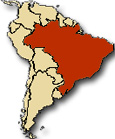
![]()
| :: Tijuana :: Santiago ...:: Sao Paulo :: Canada :: Italia |
|
SÃO PAULO, BRAZIL |
|||||||||||||||||||||||||
| MONITORING | |||||||||||||||||||||||||
| PUBLIC AND POLITICAL DEBATE EVOLUTION ....:: January 2008 ....:: July 2007 ....:: January 2007 ....:: October 2006 |
|||||||||||||||||||||||||
| CITY OVERVIEW |
|
||||||||||||||||||||||||
Historical background In the second half of the 20th century, European immigration to Brazil declined, partly due to improved economic conditions in Europe. After 1950, the number of immigrants arriving in São Paulo decreased and migrants from other Brazilian regions, particularly the poor Northeast State, took over. After the 1980s, Brazil’s economic crisis brought immigration from advanced economies close to a halt – indeed as migration flows inverted, Brazil became a country of emigration for the first time ever. Today, an estimated 2.5 million Brazilians are living abroad, or around 1.3 per cent of the total population. |
|||||||||||||||||||||||||
During the 1990s, the foreign population in São Paulo fell by 16.3 per cent. In 1991, the city was host to an estimated 219,178 foreigners (or 2.3 per cent of the total population), but by the year 2000 the number had dropped to 195,643 (1.9 per cent of the total), or 23,535 fewer foreigners residing in the city. Although the total foreign-born population has decreased, the number of immigrants from other Latin American countries to Brazil has increased since the 1970s, evincing a shift in the pattern of immigration towards the end of the 20th century. Actual issues The majority of immigrants arriving in the city of São Paulo from other Latin American countries are employed in the textile-apparel industry. In addition to offering large numbers of jobs and employing immigrant labour, the industry is familiar to many migrants, especially Bolivians who may already have the required set of skills. Working conditions – in either Korean- or Bolivian-owned workshops – are dreadful, with up to 18 hours’ work per day, Monday to Saturday, in slave-like conditions. Workers often spend the night on the workshop floor, in frequently cramped conditions with poor lighting and poor ventilation. The unhealthy and overcrowded working conditions of many of the new immigrants cause many health problems. The most common is tuberculosis through dust inhalation. The majority of immigrants do not seek out doctors, either out of fear of detention by the police, or out of ignorance of the fact that public health services are universal and free of charge in Brazil (immigrant status not withstanding). Some doctors see tuberculosis as an epidemic which, beyond Latin American immigrants, puts the whole population of São Paulo at risk after years during which there were hardly any cases (except AIDS-related). Other typical conditions among migrants include those related to the eyes, kidneys and backbone, due to the long hours spent working at the machines or sewing tables. Besides poor working, housing and health conditions, education is also a key issue for immigrants in São Paulo. Language and cultural differences stand in the way of the free education provided by the State and the municipality. For all these obstacles, immigrant families are increasingly taking advantage of public education opportunities in the city. Although São Paulo’s population is, on the whole, welcoming of foreigners when white and from developed or European countries, the same does not necessarily hold with immigrants from poor countries. These groups are often stigmatised as coca growers (Bolivians), drug traffickers (Colombians) or smugglers (Paraguayans). Moreover, immigrants are increasingly perceived as being exploited and the fact that many of the textile-apparel workshops are owned by fellow immigrants may suggest to some that these communities are exploiting their own. These negative perceptions relate to a certain reluctance among paulistas to include “Latin American” (albeit the city is itself Latin American) ethnic and cultural diversity into the image of the city as a melting pot. “The ethnic and cultural diversity of these immigrants, instead of being seen as a plus, is associated with poverty and their rural and Indian origins (Quechua, Aymará, Guarani), and, therefore, synonymous with underdevelopment.” The general public in São Paulo does not yet perceive international migration as a major issue. After all, when the city’s 10 million inhabitants face the enormous environmental, economic and social problems of a mega-city, the presence of 100,000 to 200,000 “invisible” foreigners working in poor conditions should be no cause for much concern. However, the number of newspaper articles and TV programmes reporting on illegal factories and the working conditions associated with them, has significantly increased in recent years, reflecting mounting concerns. When immigrants do get some recognition, it is often associated with prejudices and stereotypes: all Andean and other Indian groups are cast as “Bolivians.” Brazilians have little sensitivity to the various nationalities, and still much less so to ethnic, linguistic, regional and cultural differences. Brazil’s national immigration policy is still largely based on a legal framework inherited from the previous military government, such as the National Council for Immigration established in 1980 to regulate these matters. Despite the growing number of immigrants from other Latin American countries living in the city, the municipality of São Paulo still lacks any specific policy or programme dealing with these groups. This deficiency may contribute to the already large number of marginalised residents in the city. However, in areas such as healthcare and education, isolated attempts to address immigrant concerns are occurring. |
|||||||||||||||||||||||||
Renato Cymbalista, Kazuo Nakano |
|||||||||||||||||||||||||
